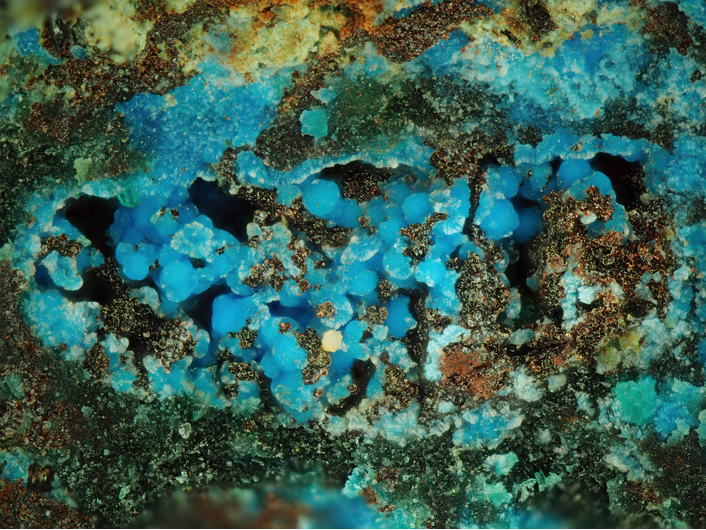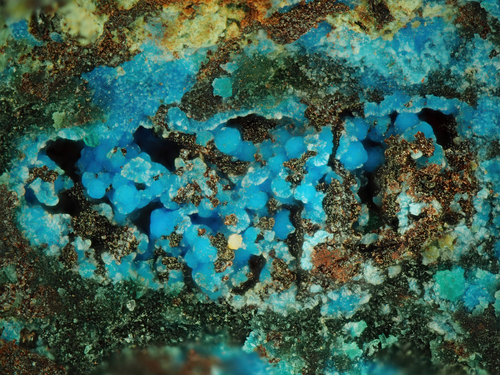Camérolaite
A valid IMA mineral species
This page is currently not sponsored. Click here to sponsor this page.
About Camérolaite
Formula:
Cu6Al3(OH)18(H2O)2[Sb(OH)6](SO4)
Originally assumed to be Cu4Al2(HSbO4,SO4)(CO3)(OH)10·2H2O
Colour:
Blue-green
Lustre:
Silky
Specific Gravity:
3.1
Crystal System:
Triclinic
Member of:
Name:
Named in honor of Michel Camérola, French mineral collector.
Cyanotrichite Group.
Closely related to carbonatecyanotrichite, less so to cyanotrichite.
The Sb:S ratio appears to be variable (Walenta, 1995). Type camérolaite has S:Sb = 1:1.44; material from the Clara mine has 1:0.64 (Walenta, 1995), although both have nearly identical X-ray powder diffraction patterns; the refractive indices of the Clara material are lower, however, due to the lower Sb content.
Closely related to carbonatecyanotrichite, less so to cyanotrichite.
The Sb:S ratio appears to be variable (Walenta, 1995). Type camérolaite has S:Sb = 1:1.44; material from the Clara mine has 1:0.64 (Walenta, 1995), although both have nearly identical X-ray powder diffraction patterns; the refractive indices of the Clara material are lower, however, due to the lower Sb content.
Unique Identifiers
Mindat ID:
872
Long-form identifier:
mindat:1:1:872:5
GUID
(UUID V4):
(UUID V4):
82682970-4530-4e89-9dcc-34bfdd3353bd
IMA Classification of Camérolaite
Classification of Camérolaite
7.DE.75
7 : SULFATES (selenates, tellurates, chromates, molybdates, wolframates)
D : Sulfates (selenates, etc.) with additional anions, with H2O
E : With only medium-sized cations; unclassified
7 : SULFATES (selenates, tellurates, chromates, molybdates, wolframates)
D : Sulfates (selenates, etc.) with additional anions, with H2O
E : With only medium-sized cations; unclassified
44.3.11.1
44 : ANTIMONATES
3 : Miscellaneous
44 : ANTIMONATES
3 : Miscellaneous
12.2.24
12 : Carbonates with other anions
2 : Carbonates with sulphate
12 : Carbonates with other anions
2 : Carbonates with sulphate
Mineral Symbols
As of 2021 there are now IMA–CNMNC approved mineral symbols (abbreviations) for each mineral species, useful for tables and diagrams.
| Symbol | Source | Reference |
|---|---|---|
| Cmé | IMA–CNMNC | Warr, L.N. (2021). IMA–CNMNC approved mineral symbols. Mineralogical Magazine, 85(3), 291-320. doi:10.1180/mgm.2021.43 |
Physical Properties of Camérolaite
Silky
Transparency:
Transparent
Colour:
Blue-green
Streak:
light green
Tenacity:
Brittle
Cleavage:
Distinct/Good
{100} and {001}
{100} and {001}
Fracture:
Fibrous
Density:
3.1(1) g/cm3 (Measured) 3.09 g/cm3 (Calculated)
Comment:
Calculated for idealized formula
Optical Data of Camérolaite
Type:
Biaxial (+)
RI values:
nα = 1.626 nβ = 1.646 nγ = 1.682
2V:
Measured: 75° to 77°, Calculated: 76°
Max Birefringence:
δ = 0.056

Image shows birefringence interference colour range (at 30µm thickness)
and does not take into account mineral colouration.
and does not take into account mineral colouration.
Surface Relief:
Moderate
Dispersion:
weak
Pleochroism:
Visible
Comments:
α = colorless, β = pale-green, γ = blue-green.
Chemistry of Camérolaite
Mindat Formula:
Cu6Al3(OH)18(H2O)2[Sb(OH)6](SO4)
Originally assumed to be Cu4Al2(HSbO4,SO4)(CO3)(OH)10·2H2O
Originally assumed to be Cu4Al2(HSbO4,SO4)(CO3)(OH)10·2H2O
Crystallography of Camérolaite
Crystal System:
Triclinic
Class (H-M):
1 - Pedial
Space Group:
P1
Cell Parameters:
a = 6.3310(13) Å, b = 2.9130(6) Å, c = 10.727(2) Å
α = 93.77(2)°, β = 96.34(3)°, γ = 79.03(3)°
α = 93.77(2)°, β = 96.34(3)°, γ = 79.03(3)°
Ratio:
a:b:c = 2.173 : 1 : 3.682
Unit Cell V:
192.82 ų
Z:
1
Morphology:
Acicular, fibrous, micaceous.
Comment:
Pseudomonoclinic. May be described with a C-centred triclinic cell with a = 12.441(3), b = 2.9130(6), c = 10.727(2) Å, α = 93.77(3), β = 95.57(3), γ = 92.32(3)° (C1, Z = 0.666).Originally assumed cell: a = 10.76, b = 2.90, c = 12.52 Å, beta = 95.61°.
X-Ray Powder Diffraction
Powder Diffraction Data:
| d-spacing | Intensity |
|---|---|
| 5.62 Å | (50) |
| 5.160 Å | (90) |
| 4.276 Å | (100) |
| 3.565 Å | (40) |
| 2.380 Å | (35) |
| 2.326 Å | (35) |
Geological Environment
Paragenetic Mode(s):
| Paragenetic Mode | Earliest Age (Ga) |
|---|---|
| Stage 7: Great Oxidation Event | <2.4 |
| 47a : [Near-surface hydration of prior minerals] | |
| 47b : [Sulfates and sulfites] | |
| 47d : [Arsenates, antimonates, selenates, bismuthinates] |
Type Occurrence of Camérolaite
General Appearance of Type Material:
Camerolaite forms tufts and radiating fibrous aggregates (0.5-2mm) of acicular crystals
Place of Conservation of Type Material:
Mineralogy Department of the Natural History Museum, Geneva, Switzerland.
Associated Minerals at Type Locality:
Synonyms of Camérolaite
Other Language Names for Camérolaite
German:Camerolait
Spanish:Camerolaita
Relationship of Camérolaite to other Species
Member of:
Other Members of this group:
| Carbonatecyanotrichite | Cu4Al2(CO3,SO4)(OH)12 · 2H2O | Mon. 2/m : B2/m |
| Cyanotrichite | Cu4Al2(SO4)(OH)12 · 2H2O | Mon. 2/m : B2/m |
| Khaidarkanite | Cu4Al3(OH)14F3 · 2H2O | Mon. 2/m : B2/m |
Common Associates
Associated Minerals Based on Photo Data:
| 5 photos of Camérolaite associated with Quartz | SiO2 |
| 4 photos of Camérolaite associated with Azurite | Cu3(CO3)2(OH)2 |
| 2 photos of Camérolaite associated with Malachite | Cu2(CO3)(OH)2 |
| 2 photos of Camérolaite associated with Gypsum | CaSO4 · 2H2O |
| 2 photos of Camérolaite associated with Langite | Cu4(SO4)(OH)6 · 2H2O |
| 2 photos of Camérolaite associated with Brochantite | Cu4(SO4)(OH)6 |
| 1 photo of Camérolaite associated with Lavendulan | NaCaCu5(AsO4)4Cl · 5H2O |
| 1 photo of Camérolaite associated with Mansfieldite | AlAsO4 · 2H2O |
| 1 photo of Camérolaite associated with Bindheimite | Pb2Sb2O6O |
| 1 photo of Camérolaite associated with Tetrahedrite Subgroup | Cu6(Cu4C2+2)Sb4S12S |
Related Minerals - Strunz-mindat Grouping
| 7.DE. | Cossaite | (Mg0.5,◻)Al6(SO4)6(HSO4)F6 · 36H2O |
| 7.DE. | Magnesioalterite | Mg2Fe3+4(SO4)4(C2O4)2(OH)4 · 17H2O |
| 7.DE. | Liangjunite | K2(Mo2O5)(SO4)2 · 3H2O |
| 7.DE. | Fabritzite | Zn9(SO4)2(OH)12Cl2 · 6H2O |
| 7.DE. | Downsite | K2(MoO3)3(SO4) · 4H2O |
| 7.DE.05 | Mangazeite | Al2(SO4)(OH)4 · 3H2O |
| 7.DE.10 | Carbonatecyanotrichite | Cu4Al2(CO3,SO4)(OH)12 · 2H2O |
| 7.DE.10 | Cyanotrichite | Cu4Al2(SO4)(OH)12 · 2H2O |
| 7.DE.10 | UKI-1975-(SO:AlCu) | (Cu, Al, SO4, H2O) |
| 7.DE.15 | Schwertmannite | Fe3+16(OH,SO4)12-13O16 · 10-12H2O |
| 7.DE.20 | Tlalocite | Cu10Zn6(Te6+O4)2(Te4+O3)(OH)25Cl · 27H2O |
| 7.DE.25 | Utahite | MgCu4Zn2Te6+3O14(OH)4 · 6H2O |
| 7.DE.35 | Coquandite | Sb6+xO8+x(SO4)(OH)x(H2O)1- x (x = 0.3) |
| 7.DE.40 | Osakaite | Zn4(SO4)(OH)6 · 5H2O |
| 7.DE.42 | Alterite | Zn2Fe3+4(SO4)4(C2O4)2(OH)4 · 17H2O |
| 7.DE.45 | Wilcoxite | MgAl(SO4)2F · 17H2O |
| 7.DE.45 | Barrotite | Cu9Al(HSiO4)2[(SO4)(HAsO4)0.5](OH)12 · 8H2O |
| 7.DE.47 | Tiberiobardiite | {Cu9Al[SiO3(OH)]2(OH)12(H2O)6}(SO4)1.5 · 10H2O |
| 7.DE.50 | Stanleyite | (V4+O)(SO4) · 6H2O |
| 7.DE.50 | Bouškaite | (MoO2)2O(SO3OH)2(H2O)4 |
| 7.DE.57 | Khangalasite | Fe(SO4)(OH) · 2H2O |
| 7.DE.60 | Hydrobasaluminite | Al4(SO4)(OH)10 · 12-36H2O |
| 7.DE.62 | Volaschioite | Fe4(SO4)O2(OH)6 · 2H2O |
| 7.DE.65 | Zaherite | Al12(SO4)5(OH)26 · 20H2O |
Fluorescence of Camérolaite
Nonfluorecent
Other Information
Notes:
Dissolves in HCl
Health Risks:
No information on health risks for this material has been entered into the database. You should always treat mineral specimens with care.
Internet Links for Camérolaite
mindat.org URL:
https://www.mindat.org/min-872.html
Please feel free to link to this page.
Please feel free to link to this page.
Search Engines:
External Links:
Mineral Dealers:
References for Camérolaite
Reference List:
Jambor, John L., Puziewicz, Jacek (1992) New Mineral Names. American Mineralogist, 77 (9-10) 1116-1121
Mills, S. J., Christy, A. G., Schnyder, C., Favreau, G., Price, J. R. (2014) The crystal structure of camerolaite and structural variation in the cyanotrichite family of merotypes. Mineralogical Magazine, 78 (7) 1527-1552 doi:10.1180/minmag.2014.078.7.02
Williams, P. A., Hatert, F., Pasero, M., Mills, S. J. (2015) New minerals and nomenclature modifications approved in 2014 and 2015. Newsletter No 23. Mineralogical Magazine, 79 (1) 51-58 doi:10.1180/minmag.2015.079.1.05
Localities for Camérolaite
Locality List
 - This locality has map coordinates listed.
- This locality has map coordinates listed.
 - This locality has estimated coordinates.
ⓘ - Click for references and further information on this occurrence.
? - Indicates mineral may be doubtful at this locality.
- This locality has estimated coordinates.
ⓘ - Click for references and further information on this occurrence.
? - Indicates mineral may be doubtful at this locality.
 - Good crystals or important locality for species.
- Good crystals or important locality for species.
 - World class for species or very significant.
(TL) - Type Locality for a valid mineral species.
(FRL) - First Recorded Locality for everything else (eg varieties).
- World class for species or very significant.
(TL) - Type Locality for a valid mineral species.
(FRL) - First Recorded Locality for everything else (eg varieties).
All localities listed without proper references should be considered as questionable.
Austria | |
| Neuhold et al. (2010) |
| Auer et al. (2017) |
France | |
| Favreau et al. (2003) |
| Toulouse analysis |
| Mineralogical Society of America - ... | |
| Jean-Marie Claude collection +1 other reference |
Germany | |
| Walenta (1995) |
| Walenta (1985) +2 other references |
Italy | |
| Ciriotti et al. (2006) |
| Bortolozzi et al. (2015) |
Portugal | |
| Pedro Alves collection and analytical ... |
Slovakia | |
| Pauliš |
| Martin Števko (unpublished, EMPA-WDS confirmed) | |
| P. Andresen collection |
Spain | |
| Calvo (2014) |
Switzerland | |
| CUCHET (1995) +2 other references |
| Ansermet (2012) |
Quick NavTopAbout CamérolaiteUnique IdentifiersIMA Classification Classification Mineral SymbolsPhysical Properties Optical Data Chemistry Crystallography X-Ray Powder DiffractionGeological EnvironmentType Occurrence SynonymsOther LanguagesRelationshipsCommon AssociatesStrunz-MindatFluorescence Other InformationInternet Links References Localities Locality List






 symbol to view information about a locality.
The
symbol to view information about a locality.
The 





Cap Garonne Mine, Le Pradet, Toulon, Var, Provence-Alpes-Côte d'Azur, France